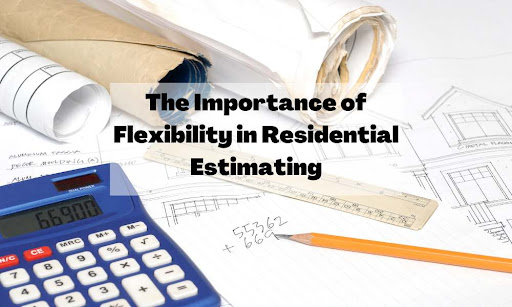
When it comes to residential estimating, flexibility is key. Every construction project has unique challenges and requirements, and a rigid approach to estimating can cause delays and cost overruns. By incorporating flexibility into your estimating process, you can ensure that your estimates are accurate, adaptable, and cost-effective. In this blog post, we’ll explore the importance of flexibility in residential estimating and provide expert tips to help you incorporate it into your estimating process.
Why is flexibility important in residential estimating? For starters, no two construction projects are the same. Even if you’re working on a similar project, the site conditions, client needs, and other variables can differ significantly. If your estimating process is too rigid, you may overlook important factors that can impact the project’s cost and timeline. Additionally, unexpected changes can arise during the project, such as design changes, weather delays, or material shortages. Without flexibility in your estimate, you may have to start over from scratch or delay the project, both of which can be costly and frustrating.
To avoid these pitfalls, it’s essential to build flexibility into your estimating process. This means taking a holistic approach to estimating, considering all factors that can impact the project’s cost and timeline. It also means being prepared to adjust your estimate as needed based on changing conditions.
The Challenges of Residential Estimating
Residential estimating is an essential aspect of the construction industry. It involves calculating the cost and time required for a construction project, from the foundation to the finishing touches. However, several challenges come with residential estimating, making it a daunting task for contractors, builders, and estimators.
Here are some of the significant challenges of residential estimating:
Unforeseen circumstances
One of the most significant challenges of residential estimating is the unforeseen circumstances that may arise during the construction process. These can include soil conditions, hidden damages, or unexpected discoveries during the demolition stage. These circumstances can cause project delays, increase costs, and affect the overall quality of the project.
To mitigate this challenge, estimators must consider the potential risks that may arise during the project’s lifespan. They can also build in contingency plans and allocate additional resources to cater to unexpected costs.
Changes in client’s preferences
Another challenge of residential estimating is dealing with changes in the client’s preferences. As the project progresses, the client may change their mind on certain aspects of the construction, such as the type of finishes, the layout of the rooms, or the fixtures to be installed. These changes can lead to additional costs and can also affect the project’s timeline.
To manage this challenge, estimators must keep a clear line of communication with the client and have a process for managing change orders. They can also provide options for the client to choose from during the design phase to reduce the chances of changes during the construction phase.
Weather conditions
Weather conditions can significantly affect the construction process, especially in areas prone to extreme weather events. For instance, heavy rains or snow can cause delays and affect the quality of the work done. Additionally, extreme temperatures can affect the curing process of concrete and other materials, leading to defects in the final product.
To overcome this challenge, estimators can take into account the typical weather patterns for the construction location and allocate additional resources to cater for potential weather-related delays.
Availability of materials
The availability of construction materials can also pose a significant challenge for residential estimating. This is especially true for rare or specialized materials that may be in high demand, leading to price hikes or delayed delivery times. Estimators must also consider the lead time for materials to be delivered to the site and how this may affect the project’s timeline.
To manage this challenge, estimators can work with suppliers to secure pricing and delivery times for critical materials. They can also provide alternative options for materials that may be in short supply to reduce the impact of any delays.
Importance of Flexibility in Residential Estimating
As a residential estimator, your primary responsibility is to provide accurate and reliable estimates to your clients. However, there are many variables that can impact your ability to provide accurate estimates. One of the most critical factors that can affect the accuracy of your estimates is flexibility.
Flexibility refers to the ability to adapt and adjust to changing circumstances. In the context of residential estimating, flexibility is critical for several reasons, including better communication with clients, the ability to make quick changes, adaptability to unexpected situations, and increased accuracy of estimates.
Better Communication with Clients
One of the key benefits of being flexible as a residential estimator is that it can help you communicate more effectively with your clients. The ability to listen to their concerns, understand their needs, and adjust your estimates accordingly can go a long way in building trust and developing a strong relationship with them.
For example, if a client has a specific budget in mind, but the cost of materials or labor increases unexpectedly, you can work with them to identify alternative solutions or adjust the scope of the project to meet their budget requirements.
Ability to Make Quick Changes
In the construction industry, change is inevitable. There are countless variables that can impact the timeline and budget of a project, such as weather conditions, supplier delays, or unexpected issues with the site. As a residential estimator, it’s crucial to be able to respond quickly and make changes on the fly to keep the project on track.
For example, if a delivery of materials is delayed, you may need to adjust the timeline of the project to account for the delay. Being flexible and adaptable can help you make these changes quickly and efficiently, minimizing the impact on the project’s overall timeline.
Adaptability to Unexpected Situations
No matter how well you plan a project, there will always be unexpected situations that arise. Being flexible as a residential estimator means that you’re able to respond quickly and effectively to these situations, minimizing their impact on the project.
For example, if an unexpected issue arises during the construction process that requires additional labor or materials, you can work with your team to identify a solution that meets the needs of the project while staying within budget.
Increased Accuracy of Estimates
Finally, being flexible as a residential estimator can help increase the accuracy of your estimates. By considering different scenarios and adjusting your estimates accordingly, you can provide a more accurate picture of the total cost of the project.
For example, if you anticipate a delay in the delivery of materials, you can adjust the timeline of the project accordingly, which can impact the overall cost. By accounting for these variables, you can provide a more accurate estimate that reflects the true cost of the project.
Conclusion
In summary, flexibility is crucial in residential estimating. By incorporating flexibility into your estimating process, you can ensure that your estimates are accurate, adaptable, and cost-effective. To build flexibility into your estimating process, start by taking a holistic approach to estimating, considering all factors that can impact the project’s cost and timeline. Additionally, be prepared to adjust your estimate as needed based on changing conditions. Finally, stay open to new ideas and approaches that can help you improve your estimating process over time. By prioritizing flexibility in your estimating process, you can set your construction projects up for success and avoid costly delays and overruns.








